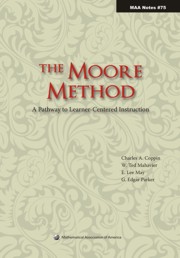Book contents
- Frontmatter
- Contents
- Dedication
- Acknowledgements
- 1 Introduction
- 2 Moore's Moore Method
- 3 What is the Moore Method?
- 4 On Culture
- 5 Development and Selection of Materials
- 6 In the Classroom
- 7 Grading
- 8 Why Use the Moore Method?
- 9 Evaluation and Assessment: Effectiveness of the Method
- 10 Frequently Asked Questions
- Appendices
- About the Authors
- References
- Index
1 - Introduction
- Frontmatter
- Contents
- Dedication
- Acknowledgements
- 1 Introduction
- 2 Moore's Moore Method
- 3 What is the Moore Method?
- 4 On Culture
- 5 Development and Selection of Materials
- 6 In the Classroom
- 7 Grading
- 8 Why Use the Moore Method?
- 9 Evaluation and Assessment: Effectiveness of the Method
- 10 Frequently Asked Questions
- Appendices
- About the Authors
- References
- Index
Summary
“…the secret of education lies in respecting the pupil…”
—Ralph Waldo EmersonQuietly but steadily, the ground is being prepared for an eventual shift in American colleges away from a teacher-oriented system featuring lectures delivered to passive audiences to a more learner-centered process in which students become more actively involved in their own education and professors adapt their teaching in accordance with more complex understandings of human learning.
(Bok, 2006)A child learns, at any moment, not by using the procedure that seems best to us, but the one that seems best to him; by fitting into his structure of ideas and relationships, his mental model of reality, not the piece we think comes next, but the one he thinks comes next. This is hard for teachers to learn, and hardest of all for the skillful and articulate, the kind often called ‘gifted.’ The more aware we are of the structural nature of our own ideas, the more we are tempted to try to transplant this structure whole into the minds of children. But it cannot be done. They must do this structuring and building for themselves.
(Holt, 1965)(Mahavier) What is the Moore Method?
Moore-method teaching has been associated with pedagogies such as discovery-based, inquiry-based, student-centered, Socratic, and constructivist, yet is not fully encompassed by any of these. The bulk of a Moore-method course will consist of student presentations of solutions to problems provided by the instructor that they produce individually without external aids.
- Type
- Chapter
- Information
- The Moore MethodA Pathway to Learner-Centered Instruction, pp. 1 - 6Publisher: Mathematical Association of AmericaPrint publication year: 2009



